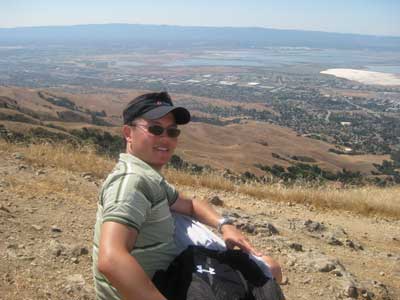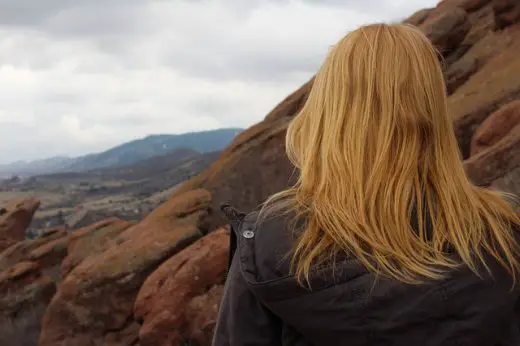
Emory Peak is the highest peak in the Chisos Mountains, which are in Texas’ Big Bend National Park. The peak is at an elevation of 2,385 meters and offers a stunning view of the surrounding park and the Chihuahuan Desert.
It’s one of the park’s most popular hikes but is also a relatively challenging one. While the trails up to the peak are well maintained and well-marked, they’re steep with some rock scrambles to navigate. It’s an 8.5-mile round trip, which will take around 5-6 hours with lots of breaks in between.
All things considered, if you’re planning on hiking up to Emory Peak it’s best to plan thoroughly; make sure you’re working on building up your fitness, stocking up on food and equipment you need to carry along and putting some thought into when you’re going to embark on your hike.
So when is the best time to hike Emory Peak? Spring or late winter, when temperatures are mild and nature is at her beautiful best. You can also consider setting out in fall, but it’s best to avoid hiking to the peak in summer. Summer months are hot, stifling, and oppressive, and you’ll go through your energy reserves twice as fast as you would in winter or spring.
Of course, there are both advantages and disadvantages of hiking in every season. Read on to explore what each season has to offer and decide what the best time to hike Emory Peak is for you.
Hiking To Emory Peak In Spring
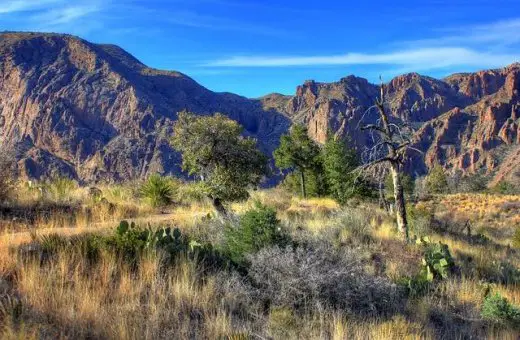
Most of the hikers who have scaled to the top of Emory Peak agree that spring is the best season for the hike. In March, April and May, the weather is good, wildflowers are in bloom and the hike becomes easier and more enjoyable.
During spring in Big Bend National Park, the temperatures are between 63F-77F at the highest and 41F-54F at their lowest. The moderate temperatures make the hike up to Emory Peak easier as you’re not sweating as much and baking in the heat. Days during spring are also more likely to be clear which promises you a better view as you ascend the mountain and once you hit the summit.
The Big Bend National Park is home to a variety of beautiful wildflowers and spring is the season when they bloom. As you hike up to the peak you’ll see meadows of wildflowers including the sunny yellow New Mexico bird’s-foot trefoil, the delicate desert holly, the chocolate flowers, and the quirkily named nodding onion flowers. In late spring some of the cacti on the trail flower; their huge red flowers are a lovely sight to see.
Spring is also a wonderful time to spot a variety of birds as you hike. As you get closer to the peak, you’ll see hummingbirds, flycatchers, wrens, cowbirds, and canyon towhees.
Spring-specific considerations
If the beckoning of ideal weather, fields of wildflowers and beautiful birds are enough to convince you to do your Emory Peak hike in Spring, there are some things to keep in mind:
- Sometimes Emory Peak is besieged with ladybugs during spring. Thousands – even millions of them make their way up to the peak during spring to feast on aphids. While the ladybugs are harmless, the sight of so many of them can be alarming to some hikers – and exciting to others. They’re not harmful, so be sure you don’t walk or step into a cloud of them.
- Along with the ladybugs, there are a few other insects that are active in spring, so be sure to take insect repellent and relief spray in case you get bitten.
- Take plenty of water: even though spring is relatively cool, Big Bend National Park is a desert, so you tend to get dehydrated faster – especially when you’re active. The trail up to Emory Peak has very few water sources, so it’s best to pack plenty of your own; 5-6 liters would be a good amount.
- On the hike up to Emory Peak you may come across some animals including snakes, lizards, deer and – on occasion – bears. Spring is the time when they’re nurturing their young, so be mindful not to approach the animals as they may feel threatened.
What to wear on a Spring hike
Wearing layers is the key to a comfortable spring hike to Emory Peak. While it’s warm, it can get a little chilly as you ascend towards the peak, so wear a t-shirt and carry along a jacket to don if you’re cold. Zp away pants are a great idea during spring hikes; convert them into shorts when it’s warm and zip back the bottoms when it becomes colder.
While the sun isn’t as harsh as it is during summer, it’s still a good idea to wear a wide-brimmed hat.
Hiking To Emory Peak in Winter
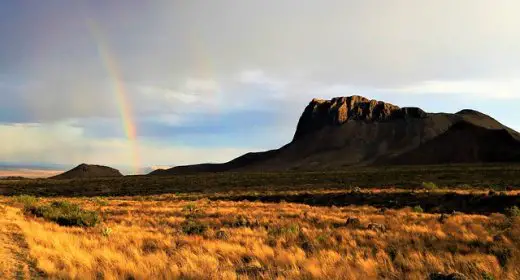
Another popular time to hike Emory Peak is in the winter; from December through to February.
Temperatures in the Big Bend National Park during winter are typically between 51F-57F, but snow is rare, making the Park a perfect place to go for winter hikes. Cold snaps do happen occasionally, during which temperatures plummet to below freezing. Snows can happen during cold snaps, so keep an eye on the weather forecast before you begin your hike, or talk to experienced park rangers so you can be more prepared.
On most winter days, however, the skies are clear, and you’ll enjoy breathtaking views as you do the climb. Most of the fauna in the area is multi-seasonal, and as you hike, you’ll pass through woodlands filled with oak and juniper trees and spiky yucca and cacti.
Typically, fewer people are hiking in Big Bend during the winter, so you’ll enjoy solitude and quiet, especially once you reach the peak.
Winter-specific considerations
If the hiking bug bites you during the winter, Emory Peak is a great hike to go on. But, there are a few things to keep in mind while preparing:
- Even when it snows, it never gets deep enough to need snowshoes, ice picks, or other snow hiking gear, so there’s no need to burden your pack with it.
- However, the last quarter mile to reach the peak involves some semi-technical rock scrambling and during winters the rocks can be covered with ice. You don’t need scrambling gear, but sturdy gloves will be helpful to maintain your grip.
- Days are shorter in the winter, so plan to start your hike earlier to make sure you’re not hiking in the dark.
- While you won’t necessarily feel cold when hiking, your body will be working to keep you warm. So, carry energy-rich food like trail mix, jerky, and dried fruits. When you stop hiking, the cold may catch up with you, so bringing pre-packaged meals is a great idea. That way, you won’t be shivering as you’re assembling a meal!
What to wear on a Winter hike
Layers are the key to ensure that you stay warm during your hike. Wear insulating underclothes topped with long sleeved shirts and pants and carry a thick jacket that you can wear once you reach the peak. Thick socks and shoes will also help keep you warm. Wearing shoes with cleats is advisable, just in case the trail close to the peak is coated with ice.
Hiking To Emory Peak in Fall
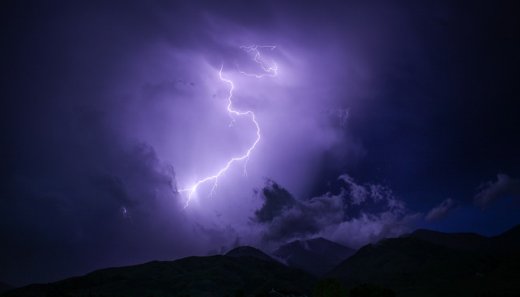
Winter and spring are the ideal times to hike to Emory peak, but if those seasons are not workable, fall is also an option.
This article is owned by Recapture Nature and was first published on October 25, 2019
Temperatures during September, October and November are mild – they range between 39F, at their lowest to 72F at their lowest. September and October are also some of the rainiest months in the Big Bend Park; occasionally there are fierce thunderstorms with heavy rain, thunder and lightning.
However, you’ll also be treated to the sight of beautiful fall colors in the Chisos Mountains. Oak, maple and aspens transform as their leaves turn to vivid orange and red. The cacti remain green and the contrast between them and the orange leaved trees makes for a striking view.
Fall-specific considerations
If you’re planning to hike Emory Peak in fall, the most important thing to keep in mind is that it may rain and storm as you’re walking. You can make sure your hike goes smoothly in the face of heavy rains by:
- Waterproofing everything: Pack your food, maps, first aid kit and other essentials in dry bags.
- Getting an early start: Rain typically makes its appearance in the late afternoon, so if you get an early start you may be able to reach the summit before it starts to pour. This will not only make the ascent easier, but also make sure your view from the summit is not clouded by sheets of rain.
- Protecting yourself from lightning: If you’re out in the open during a lightning storm, take off your backpack and any other metals and keep them at least 100 feet away from you. Assume the lightning position; crouch down, as low as you can go and put your hands over your ears. When lightning hits the ground, it causes electric currents which can be extremely harmful. The lightning position reduces the amount of contact you have with the ground.
- Spreading out: If you’re hiking in a group, spread out during the storm, putting as much distance between yourselves as possible. In case lightning strikes nearby or a branch falls, your whole group won’t be injured and will be in a better position to help others.
- Use hiking poles: On a slipper trail, hiking poles will help you get a better grip and stop you from slipping.
- Checking the forecast: If the forecast or park rangers predict that there are going to be thunderstorms, put off the hike for the next day if you can.
- Watch out for rain snakes: During the rainy season, rain snakes emerge from underground and can be found on the trail. Pay extra attention to the trail in case one has set up shop on your path and step around it!
Fall is also when all the bears are at their most active. As they’re preparing for their winter hibernation, they’re foraging for food and looking for dens. So, your chances of coming across a bear are much higher in fall. If you see a bear, back off and allow it to cross the trail before you continue.
What to wear on a Fall hike
Everything you’re wearing on a Fall hike up to Emory Peak should be either waterproof or quick drying. Polyester and nylon are the best fabrics to wear as they are light and dry quickly. A rain jacket with a hood should be on your apparel list as well as waterproof, non-slip shoes. Carrying along a rain hat with a broad brim will also be helpful in keeping your hair dry and warm.
This article is owned by Recapture Nature and was first published on October 25, 2019
Hiking To Emory Peak in Summer

By far the worst time to attempt to summit Emory Peak is in the Summer. Big Bend National Park is a desert and in summers temperatures soar to approximately 86F. June is the hottest, but July and August are also extremely hot and dry.
Hiking during these temperatures can be tough, hard work and you may develop a bad sunburn or – even worse – a severe case of heatstroke. The trail has very few trees on its immediate vicinity, so there’s very little natural shade. Another concern is that the few springs on the trail dry up in Summer so there are no natural sources of water.
Most of the bigger animals like bears and deer seek respite in wooded areas in summer so you won’t see too many of them. However, summer brings out plenty of insects; there are over 3600 different types of insects in the area and some may decide to join you on your trail.
During especially hot summers, there’s also a mild risk of wildfires; in May 2019, a fire burned through 800 acres of the Big Bend National Park – not an ideal situation to be hiking in!
Summer-specific considerations
However, just because conditions during summer are not ideal for a hike up to Emory Peak, it’s not impossible. You just have to make sure you’re well-prepared. To beat the heat, here are some things you can do:
- Start the day early: Try to begin your hike before dawn so that by the time the sun is at its hottest, you’re already at the top of Emory Peak.
- Carry lots (and lots) of water: It’s very easy to get dehydrated in the Chisos Mountains, and you’ll be sweating a lot as you make the ascent. Carry at least 8 litres of water and more if you can manage it.
- Pack sodium-rich foods: When you’re sweating, you’ll lose both water and sodium, and it’s essential to replenish your body’s supply of both. Salted nuts and preserved meats like ham are great options. Leafy greens and tomatoes are also ideal to have in your hiking lunchbox as they have a high water content. You can also bring electrolyte replacements to mix in your water.
- Use lots of sunscreen: Protect yourself from painful sunburn by going crazy with the sunscreen. Remember to reapply it every two hours!
- Take frequent breaks: Even if you’re trying to make good time, allow yourself regular breaks to cool down and rest your muscles.
- Hike in groups: In summer the trail up to Emory peak is at its quietest because of the heat. Don’t attempt the hike alone; have someone who can help in case of emergencies.
If you do feel like you’re beginning to suffer from heat exhaustion (symptoms include headaches, nausea, and muscle cramps), then don’t take a chance – start heading back to the trailhead and try attempting the hike on another day.
What to wear on a Summer hike
When you’re hiking up to Emory Peak in summer, you want to be wearing loose, breathable clothes that cover as much skin as possible. This this is a measure that will guard you against the sun. Get special sun protective clothing and a hat and sunglasses.
Best Time of Day To Hike Up To Emory Peak
Picking the correct season to ascend to Emory Peak is important, but so is stepping out at the right time of day. Typically, the earlier you begin your hike, the better – it’s best to begin just as the sun is rising. Sunrise in the Chisos Mountains is at around 7:30am through all seasons. The hike will take you six hours. So if you get an early start you can be back by early afternoon just before the sun is at its hottest.
If you get an early start and plan your time well, you can hike Emory Peak at any time of the year. However, it’s best to aim for spring or late winter so that weather conditions like extreme heat or thunderstorms don’t get in your way.
If you do plan to hike in summer or fall, make sure that you’re well equipped and prepared. It’s a good idea to hike in groups in case of injuries. During spring, there are plenty of other hikers on the trail that could give you a hand.
This article is owned by Recapture Nature and was first published on October 25, 2019
Plan your hike well, and you’ll successfully summit Emory Peak, the Chisos Mountains highest point.

